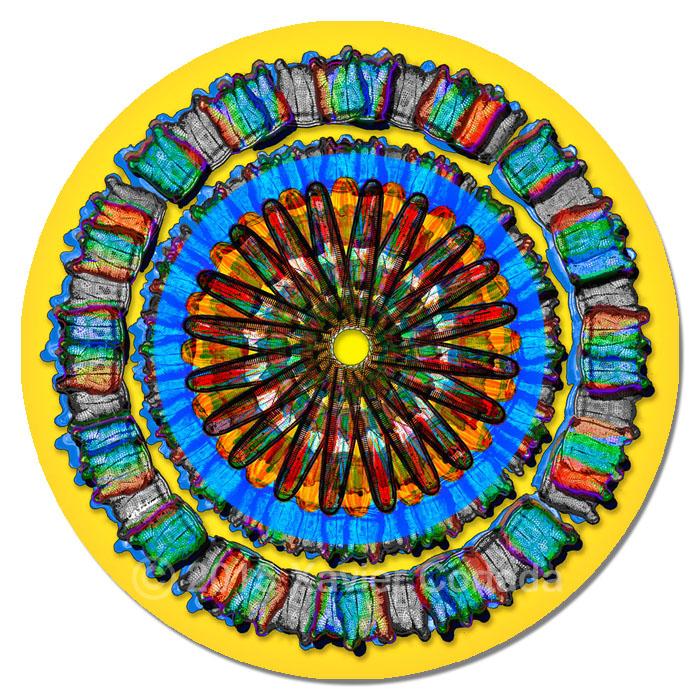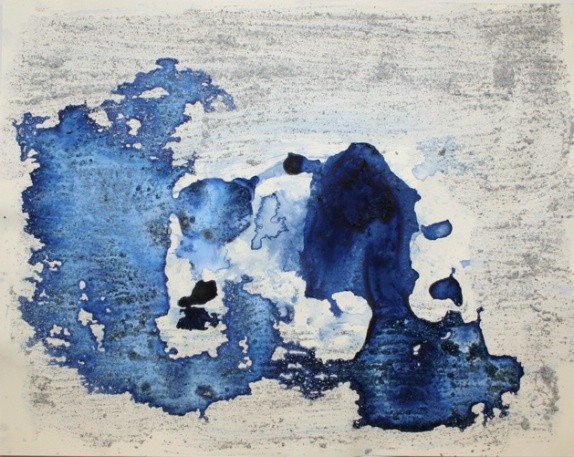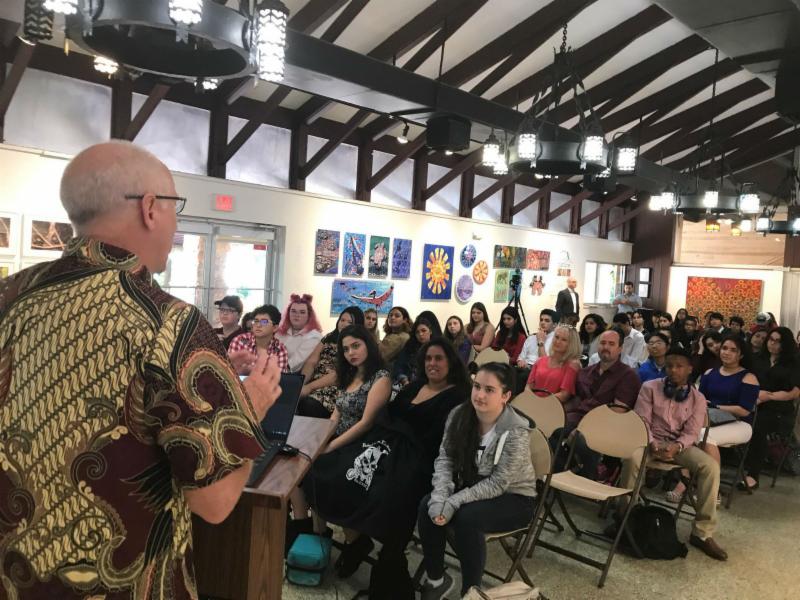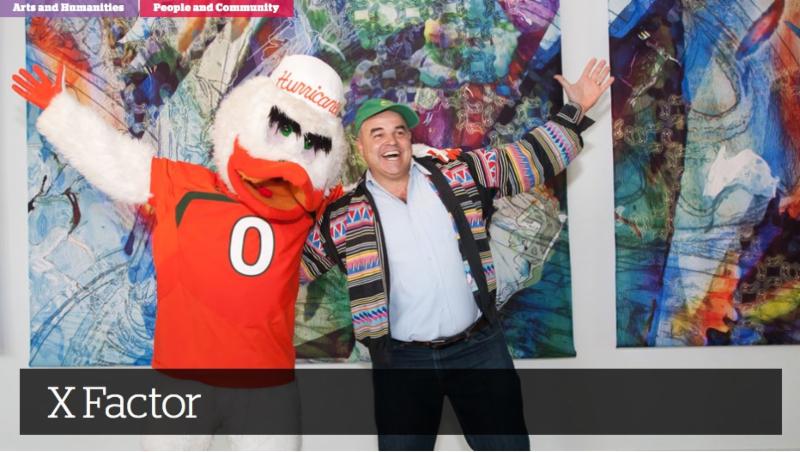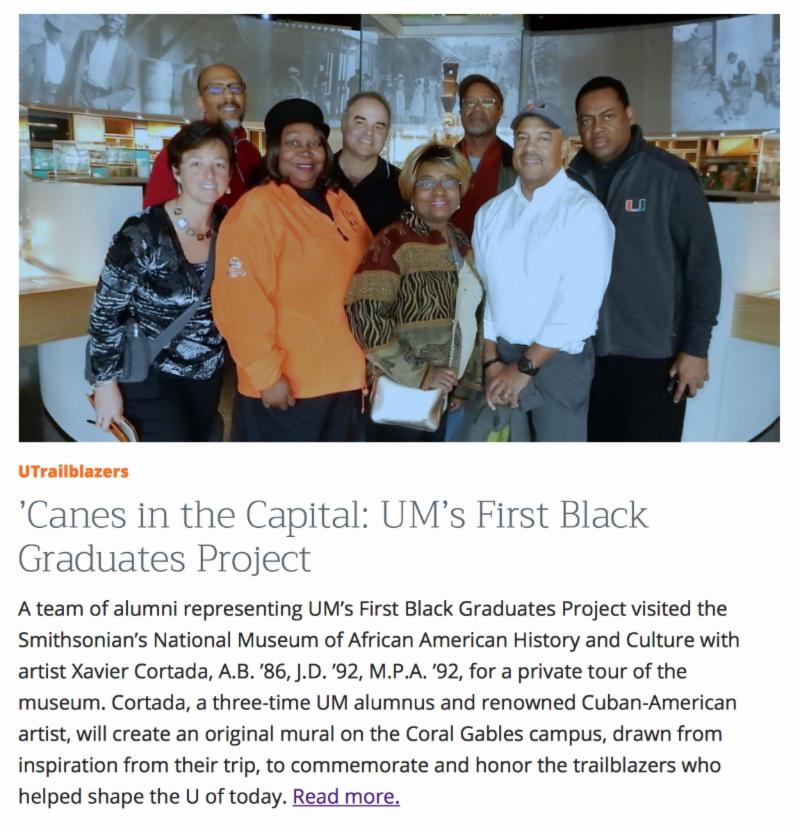Home » Newsletters » 2018 News » March 2018 – The Frank
Xavier Cortada, Florida is… Diatoms | Glow , 2015
FLORIDA IS…
a solo exhibition by
Xavier Cortada
at
The Frank
Frank C. Otis Art Gallery and Exhibit Hall
Pembroke Pines City Center
601 City Center Way
Pembroke Pines, FL 33156
Opening reception:
Thursday, March 29, 2018
from 6pm to 9pm
Exhibition runs March 29 – May 19, 2018
CLICK HERE to learn more.
Water Paintings
a solo exhibition of works created at
Hubbard Brook Experimental Forest
by
Xavier Cortada
Pinecrest Gardens Hibiscus Gallery
11000 SW 57th Avenue
Pinecrest, FL 33156
Opening reception:
Sunday, April 8, 2018
Noon to 2pm
Exhibition runs March 30 – April 29, 2018
CLICK HERE to learn more.
In June 2016, I placed nine pencil drawings and nine pieces of watercolor paper inside nylon mesh. I then tied the mesh bags to a rope at each of the nine weirs at Hubbard Brook Experimental Forest and left them there for a period of 16 weeks.
The water flowing through the mesh stained the paper inside. Water samples and water data were collected by scientists over the same 16-week period from the same nine weirs. The final work included water samples, data, even the residue in filters.
Water Paintings allowed me to give water at Hubbard Brook’s nine watersheds a voice. In the work, I made water the protagonist. I wanted audiences to see the water, what the water did, and what it painted as it flowed and transported materials down the stream.
–Xavier Cortada
On display at Weisman Art Museum:
Xavier Cortada, Astrid, (Antarctic Ice Paintings series), 2007
Exhibitions
- January 27 – May 13, 2018: Vanishing Ice: Alpine and Polar Landscapes in Art: 1775-2012 exhibition at Weisman Art Museum, Minneapolis, Minnesota
- March 29 – May 19, 2018: FLORIDA IS … at The Frank Gallery in Pembroke Pines, Florida (Opening reception: Thursday, March 29th 2018 from 6pm to 9pm)
- March 30 to April 29, 2018: Water Paintings exhibition opening at Pinecrest Gardens, Pinecrest, Florida (Opening reception: Sunday, April 8, 2018 from noon to 2pm)
Florida International University
College of Arts, Sciences & Education News
Published 03-08-2018
Bridging the Gap between Art and Science
In a mission to engage the next generation of leaders, scientists and creators to take an active role in protecting our local ecosystems, the School of Environment, Arts, and Society’s (SEAS) is leveraging their partnership with Pinecrest Gardens and Xavier Cortada, FIU SEAS artist-in-residence, to bring art and science together and inspire youth during the monthly “Florida Is Nature” Artist Talks held at the Garden’s Hibiscus Gallery.
Through the “Florida Is Nature” participatory art project and Talks, Xavier Cortada invites scientists to join him and an audience of Miami-Dade Public Schools students in a discussion about their research on particular Florida environmental resources and their importance to all Floridians. In Xavier’s words “‘The Florida is Nature’ project is an evolving body of work that depicts the natural beauty of Florida and asks Floridians to define their state by its natural environment, not by the edifices and man-made encroachments that displace nature.”
In 2017, two FIU scientists participated in the Talks. Dr. John Kominoski , co-Principal Investigator of the Florida Coastal Everglades Long Term Ecological Research Program led a discussion along with Xavier focused on mangroves and their role in protecting our coastlines. Dr. Hong Liu, an ecologist recognized for her restoration work and research on endangered plants, participated in the “Florida Is…Endangered Species” talk later that year.
Dr. Jim Fourqurean, President-elect of the Coastal and Estuarine Research Federation and Director of the Center for Coastal Oceans Research (CCOR) co-led the first 2018 Talk: “Florida Is…Seagrasses”. Reflecting back on his participation in the “Florida is Nature” Artist Talks, Dr. Fourquerean mentions – “I was eager to participate in the dialog about my research, the nature of Florida, and the ways artists communicate and motivate their audiences. I gained insight on new ways to effectively communicate and new ways to look at the world. I was also excited about the opportunity to do that with an audience of high school students…they are the next generation of citizens that will see to the protection of the south Florida environment through their understanding, influence in their circles of friends, and by voting. I can honestly say participating in this was one of the most fun and enlightening things I have done in quite a while!”
As of today, approximately 200 high school students from Miami-Dade Public Schools have attended these talks. The talks are also filmed by the FIU library/Digital Library of the Caribbean and shared through their online platforms.
Join the School of Environment, Arts and Society and Pinecrest Gardens as they host their monthly Florida is Nature Artist Talks.
Upcoming Artist Talks of 2018:
“Florida is … Ecosystems” Talk by Dr. Cara Rockwell–Wednesday, March 14th, 2018 at 10:30 a.m. – 11:30 a.m.
“Florida is … Nature: Sea Level Rise and Climate Change” Talk by Dr. Stephen Leatherman– Wednesday, April 11th, 2018 at 10:30 a.m. -11:30 a.m.
“Florida is … Sharks” Talk by Dr. Demian Chapman– Wednesday, May 9th, 2018 at 10:30 a.m. -11:30 a.m.
In the news
X Factor
From the North Pole to the South Pole and everywhere in between, the art of UM alumnus Xavier Cortada bridges conflict, inspires action, and teaches the world about science that matters.
Miami in the 1980s was epic, and University of Miami alumnus Xavier Cortada grew up in the thick of it. Drug wars, murders, riots, refugees—it was the perfect breeding ground for a fledgling activist to soak up the heaviness of the world and gather the quiet anger that gets things done. Like the dizzying scaffolds of mangrove roots Cortada loves to paint, his path to global renown as an artist has been bold, nonlinear, and always intertwined with a fierce undercurrent of social justice.
A New York-born Cuban-American, Cortada was a student at Miami Senior High when he won a Silver Knight Award for service to the community. Active in X Club, the school’s version of the National Exchange Club for service, he ran blood drives, manned Goodwill trucks, and assisted the elderly and immigrants. But the real grit under his skin came from the gunshot and burn victims he saw while working as an orderly at Jackson Memorial Hospital.
“In a good way,” Cortada says, “I didn’t have a sheltered anything. I grew up in a very urban landscape surrounded by societal ills and along the way found institutions that helped serve those ills. The most important one, and the one that has my eternal gratitude, is the University of Miami.”
Cortada would spend 10 formative years earning three degrees at the U. As an honors undergrad, he did cardiology research at the Veterans Affairs Medical Center, was speaker of the senate in Student Government, served on the University’s Board of Trustees and the Council of International Students and Organizations, was vice president of the biology club, and was tapped into the Iron Arrow, Mortar Board, and Omicron Delta Kappa honor societies. As a Lambda Chi Alpha brother (which he chose in part because of the Greek letter X in its name), he earned the nickname “Cubaba” while dancing to a Sheila E. song clad in a toga and sombrero during a Mr. UM contest (he won second place). Years later, Cubaba would become the title of his first-ever solo show as an artist, an exploration of his identity “being Cuban, being American, being both, and being neither.”
When he wasn’t studying for moot court or doodling sketches in his books, Cortada as a law and public affairs graduate student was ensconced in service—American Bar Association national vice chair, graduate advisor for Lambda Chi Alpha, president of ODK, and chair of Miami’s Youth Task Force. He also ran for public office, gaining 8 percent of the vote among four candidates for the Florida House of Representatives seat in his district. The win went to Fran Bohnsack, whose volunteer, Juan Carlos Espinosa, would years later become Cortada’s husband. (They reconnected in 1996 in an AOL chat room after Espinosa realized the anonymous screen name “Xmiami” belonged to Cortada.)
Cortada left his law school clerkship at a prestigious Miami firm to help build and lead an adolescent drug rehab center, Regis House. After passing the bar, Cortada was tapped by José Szapocznik, a UM pioneer in adolescent drug intervention, to become a UM research assistant professor and director of the Juvenile Violence and Delinquency Prevention Programs. The role led to speaking engagements around the world—and to an existential awakening somewhere near the top of Mount Kilimanjaro.
“I was 30 years old, standing on the mountain, asking myself, ‘Am I an artist, am I an academic, or am I an attorney?” Cortada recalls. He was at the end of a three-month tour in Europe and Africa funded by the U.S. government and had just orchestrated a breakthrough teaching moment among a group of Zulu boys using sketches instead of words.
A few months later, Cortada completed his first commission, “Hand in Hand,” a mural in Leadville, Colorado, urging a conflicted community of new and established immigrants to bridge their divide. Other consciousness-raising murals around the world soon followed—for peace in Cyprus and Northern Ireland, child welfare in South America, juvenile justice at the Miami-Dade County Courthouse, International AIDS Conferences in Geneva and South Africa, and minority homeownership at the White House.
“In many ways, being a lawyer is what prepared me most for being an artist,” Cortada says. “As a lawyer you have a duty to your clients, to safeguard their best interests. I have always advocated for my clients, which are the issues that are important to me. Now another client has knocked on my door, and this client is pretty needy, so I’ve taken the case.”
Cortada is talking about sea level rise, an imminent threat to coastal regions, including his beloved Miami.
“It’s inevitable that every piece of art I created for this town will be under water,” he says. “So my art is not about the object; it’s about the process.”
The process is what he calls “participatory art,” engaging people in unconventional ways to pique their curiosity and edge them into action.
“Biscayne Bay has eight new acres of mangroves because I decided to create the Reclamation Project,” Cortada says of the thousands of mangrove seedlings that were collected by volunteers and nurtured in clear plastic cups in museums, shops, and other public spaces from 2006 to 2012. The project continues to operate today in South Florida classrooms.
“I don’t care that a mangrove was planted; I care that you planted a mangrove,” he continues. “I go through all these crazy processes to create a sense of community, to create a strategy to make you more curious. Most of what I do is slow activism, creating a cadre of citizens who are more science literate and more loving and supportive to one another as we face the greatest challenge of our time.”
Expanding science literacy brought Cortada to the North and South Poles in 2007 and 2008, where he installed works highlighting environmental degradation, endangered species, and the passage of time. Eco- and science-based art remains a major focus of his work at Florida International University, where he has been an artist-in-residence since 2011.
Recent works include five giant banners depicting experiments that discovered the Higgs boson particle at CERN, the European Organization for Nuclear Research in Geneva; a 16-foot ceramic and mosaic sculpture in Little Havana honoring diatoms, the tiny water-borne organisms that convert carbon dioxide into oxygen; and a multimedia exhibition in Hialeah during the 2015 UN Paris Climate Change Conference that concluded with the city’s Republican mayor signing a climate action pledge.
Cortada’s works have appeared on every continent, but no matter where in the world he traveled, he never really left the University of Miami. He was an adjunct professor in pediatrics, psychiatry, and biology from the late 1990s through the next decade, and has worked with UM students on several participatory art projects, including the Reclamation Project. This year he was appointed to the UM Alumni Association Board of Directors.
He is presently working with the UM Alumni Association’s First Black Graduates Project to design a permanent installation at the Memorial Classroom Building that honors black history and inclusion at the University. When completed next year, it will be among dozens of works Cortada has donated to the University since that pivotal day near the top of Mount Kilimanjaro. In the School of Law and Frost School of Music buildings, the Newman Alumni Center, Shalala Student Center, and several other locations on and outside of the Coral Gables campus, many once-bare UM walls bear the gratitude Cortada holds for his alma mater expressed through paintings, sculptures, and digital works.
His “Flight of the Ibis,” a 15-foot by 30-foot digital tapestry that catches your eye and breath as you ascend the stairs to the top floor of the Shalala Student Center, is particularly meaningful for him because it symbolizes his own journey. Much like the way mangroves foster new life in nature, Cortada considers being a student leader who mingled with Nobel laureates and top dignitaries to be the first prop roots in his rise to a very public-facing career. It’s what allowed him, even as a young artist, to feel “an incredible comfort level” when shaking hands with such luminaries as the president of the United States and the pope.
“Mangroves are really important because they build community,” Cortada says. “A mangrove propagule lands on a sand bar, settles its roots, and begins to trap sediments. That sandbar becomes an island. The mangrove canopy provides habitat and protection, and life begins to take hold on the island.
“In many ways,” he continues, “young Xavier’s Miami needed the protection of a mangrove called the University of Miami. It allowed this ibis to grow and take flight.”

